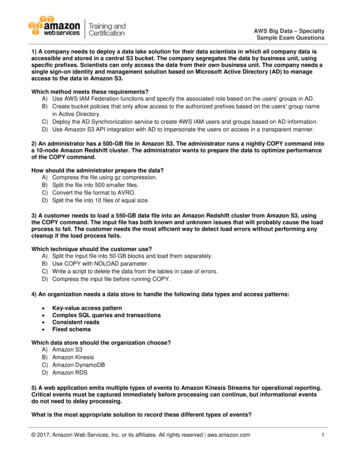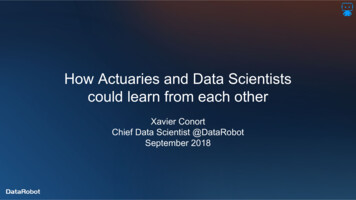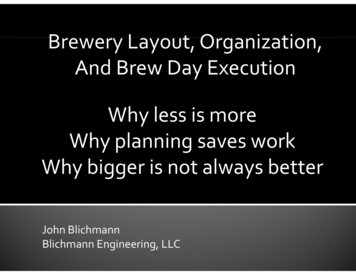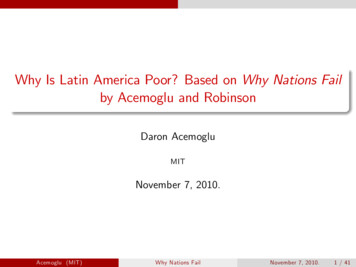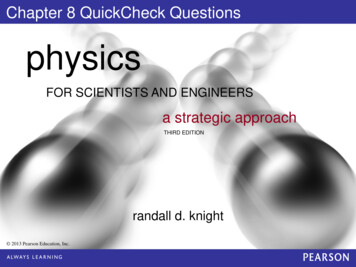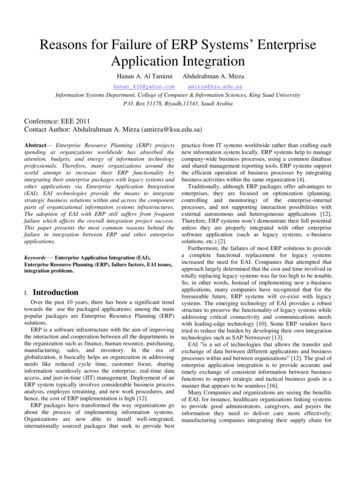
Transcription
4 Reasons Why DataScientists ShouldAdd MathematicalOptimization to TheirAnalytics ToolboxManagement Paperwww.gurobi.cominfo@gurobi.com1 (713) 871-9341Management Paper: 4 Reasons Why Data Scientists Should Add Mathematical Optimization to Their Analytics Toolbox1
4 Reasons Why Data Scientists ShouldAdd Mathematical Optimization toTheir Analytics ToolboxIt has been said that “data is the newoil”–and it’s true that data is indeeda valuable commodity in today’sbusiness world. Most companieshave the capability to collect andprocess huge quantities of data,but few are actually able to utilizetheir data to generate insights andpredictions and make decisions.However, many data scientists are stillreluctant to explore and embrace mathematicaloptimization technologies–and opt insteadto use machine learning, deep learning, andheuristic techniques to solve their businessproblems and drive their decisions.In this management paper, we will discuss fourkey reasons why every data scientist shouldadd mathematical optimization into his or heranalytics toolbox.To extract the maximum business value outof their data (by leveraging it to make optimaldecisions), companies must have the rightadvanced analytics technologies.Today’s data scientists need to have a fullanalytics toolbox at their disposal. But whichtools do they actually need?In addition to machine learning, visualization,heuristics, and other common tools, mathematical optimization is becoming an essentialtechnology for more and more data scientists.Indeed, a growing number of data scientistsare adding mathematical optimization into theiranalytics arsenals–as they are discovering thatmathematical optimization is capable of rapidlytackling complex, real-world problems (thatinvolve conflicting tradeoffs among variousbusiness objectives and an astronomicalnumber of possible solutions) and deliveringoptimal solutions.Mathematical optimization has been successfully applied by numerous companiesacross various industries–including finance,telecommunications, manufacturing, electricalpower, aviation, and transportation–to optimizetheir operational efficiency, resource utilization,and profitability.Management Paper: 4 Reasons Why Data Scientists Should Add Mathematical Optimization to Their Analytics Toolbox1
4 Reasons Why Data Scientists ShouldAdd Mathematical Optimization toTheir Analytics ToolboxReason #1: Mathematicaloptimization technologies arepowerful, fast, and easy to useIn the past, many data scientists steered clearof mathematical optimization technologies asthey had the perception that these technologieswere too slow and that mathematical optimization models were too difficult to build andmaintain. But this is simply not the case.With advances in computing power, algorithms,and data availability and quality over the lastfew decades, it is now possible for mathematical optimization technologies to rapidlyand effectively handle even the most complicated combinatorial optimization problems–and generate globally optimal solutions. Justconsider this fact: A mathematical optimizationproblem that would have taken 55 years tosolve in 1991 can be solved today (using acommercial solver) in one second!And, with recent ease-of-use improvementsto mathematical optimization technologies,data scientists with some basic mathematicalprogramming skills can easily learn how tobuild, deploy, and maintain mathematicaloptimization applications.Armed with these mathematical optimizationtechnologies, data scientists can rapidlyand automatically generate globally optimalsolutions to their complex business problems–and use those solutions as the basis for optimaldecisions that maximize their company’soperational efficiency.When facing a complex business problem,today’s data scientists can choose whichproblem-solving approach they want to use:heuristics (which are useful in some situationswhere the problem cannot be defined mathematically, but are unable to guaranteeglobally optimal solutions) or mathematicaloptimization.2Management Paper: 4 Reasons Why Data Scientists Should Add Mathematical Optimization to Their Analytics Toolbox
4 Reasons Why Data Scientists ShouldAdd Mathematical Optimization toTheir Analytics ToolboxReason #2: Mathematical optimization and machine learning can beused in a complementary mannerMore and more companies are developingapplications that combine mathematical optimization and machine learning as these twotechnologies–when deployed together–formquite a dynamic duo.Simply put, machine learning enables youto generate predictions, while mathematicaloptimization empowers you to make decisions.In today’s highly complex and constantlychanging business environment, companiesmust have the capability to:Predict what is going to happen inthe future.Use those predictions to help decideon the best courses of action.Mathematical optimization and machinelearning–when they are utilized in a complementary manner–can give you this capability.With mathematical optimization and machinelearning working in concert, you can lookinto the future and foresee likely businessconditions and outcomes, and then utilize thosepredictions to help you make optimal decisions.Mathematical optimization technologies canleverage machine learning-based predictions byusing them as input (i.e. decision constraints)for mathematical optimization-generated solutions and decisions.Management Paper: 4 Reasons Why Data Scientists Should Add Mathematical Optimization to Their Analytics Toolbox3
4 Reasons Why Data Scientists ShouldAdd Mathematical Optimization toTheir Analytics ToolboxLet’s take a look at some real-world examplesthat illustrate the power of this mathematicaloptimization and machine learning combination:LogisticsMachine learning enables logisticsproviders to predict future supplychain issues that may arise.Using those machine learning-basedpredictions as constraints, mathematicaloptimization enables logistics providersto decide on the most cost-effective wayto reroute shipments.CybersecurityMachine learning enables cybersecurityfirms to predict when and where the nextcyberattacks will occur before theyhappen.Using those machine learning-basedpredictions as constraints, mathematicaloptimization enables cybersecurityfirms to decide which investigators toassign to potential threats based on skillsets, potential damage from an attack,and other factors.RetailMachine learning enables retailers topredict customer demand for specificproducts on a daily basis.AirlinesMachine learning enables airlines to predictaircraft engine failures days before theyhappen.Using those machine learning-basedpredictions as constraints, mathematicaloptimization enables airlines to decide onthe best time to schedule maintenanceactivities in order to minimize operatingcosts and aircraft downtime.Financial ServicesMachine learning enables investmentmanagers to predict fluctuations insecurities prices and identify investmentopportunities.Using those machine learning-basedpredictions as constraints, mathematicaloptimization enables investment managersto determine how to optimize the allocationof assets in a portfolio.These are merely a few examples that show how,by combining machine learning and mathematicaloptimization in a single application, you can unlockthe true value of your business data by using it tomake optimal business decisions (based on yourpredictions and other constraints, as well as allrelevant decision variables and business objectives).Using those machine learning-basedpredictions as constraints, mathematicaloptimization enables retailers to decideon how to dynamically, optimally adjustprices for those products to maximizeprofits and customer satisfaction.Management Paper: 4 Reasons Why Data Scientists Should Add Mathematical Optimization to Their Analytics Toolbox4
4 Reasons Why Data Scientists ShouldAdd Mathematical Optimization toTheir Analytics ToolboxReason #3: Mathematical optimization can be used to improve theaccuracy of machine learning-basedpredictionsThe relationship between mathematical optimization and machine learning is a symbioticone: machine learning-based predictions (aswe discussed above) can be used to improvemathematical optimization-generated solutions,while mathematical optimization-generatedsolutions can be used to improve the accuracyof machine learning-based predictions.How does the latter process work? It’s simple:Mathematical optimization-generated solutionscan be fed back into machine learning models,and utilized as machine learning-model trainingfeatures and machine learning-model scoringand inferencing inputs.In this way, mathematical optimizationgenerated solutions can help shape, retrain,and improve machine learning models–whichoften decay over time.Reason #4: Mathematical optimizationcan be used to solve classification andprediction problemsLeading researchers in the data science field havestarted using mathematical optimization to tackleclassification and prediction problems–whichhave been traditionally addressed by using onlymachine learning algorithms.There are several advantages of using mathematical optimization to solve classification andprediction problems:Mathematical optimization improves theinterpretability of machine learning predictive models. Having an interpretablemodel that subject matter experts (SMEs)can understand and trust is critical–particularly in “life-or-death” classificationproblems like predicting cancer, heartdisease, or criminal recidivism. In theseand other instances, mathematicaloptimization models–which have featureweights that are associated with particularvariables–are easier for SMEs to graspand trust than their machine learningcounterparts.With mathematical optimization, you caneasily add constraints and preferencesto your prediction or classification modelsand effectively control the tradeoff between accuracy and interpretability. Theflexibility of mathematical optimizationenables data scientists to fine tune theirmodels based on the experience andexpertise of each SME.5Management Paper: 4 Reasons Why Data Scientists Should Add Mathematical Optimization to Their Analytics Toolbox
4 Reasons Why Data Scientists ShouldAdd Mathematical Optimization toTheir Analytics ToolboxDue to these factors, mathematical optimization is being used by leading researchers inthe data science field today to build and traininterpretable models for classification andprediction problems, and generate optimalsolutions that they (and the SMEs they workwith) can rely on to make decisions.ConclusionFor the reasons highlighted in this managementpaper, a growing group of data scientists haveadded mathematical optimization into theiranalytics toolbox.Mathematical optimization is being used bydata scientists and leading researchers todayin an ever-expanding range of applications–sometimes in combination with machinelearning, and other times on its own to addressclassification and prediction problems.With a full set of analytics tools includingmathematical optimization, data scientistscan maximize the business value of theirdata–by using it make accurate predictionsand optimal decisions.Management Paper: 4 Reasons Why Data Scientists Should Add Mathematical Optimization to Their Analytics Toolbox6
www.gurobi.cominfo@gurobi.com1 (713) 871-9341Management Paper: 4 Reasons Why Data Scientists Should Add Mathematical Optimization to Their Analytics Toolbox7
Management Paper: 4 Reasons Why Data Scientists Should Add Mathematical Optimization to Their Analytics Toolbox 6 4 Reasons Why Data Scientists Should Add Mathematical Optimization to Their Analytics Toolbox Due to these factors, mathematical optimi-zation is being used by leading researchers in the data science field today to build and train interpretable models for classification and .


